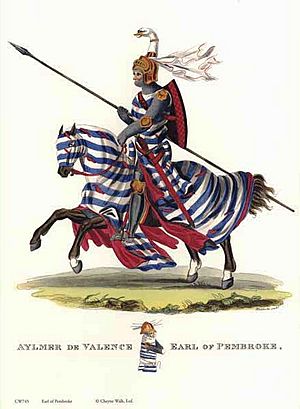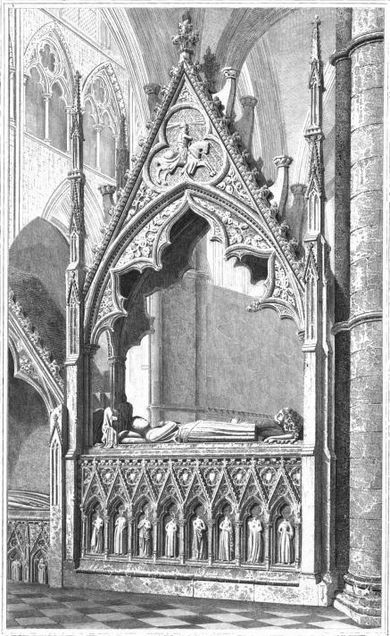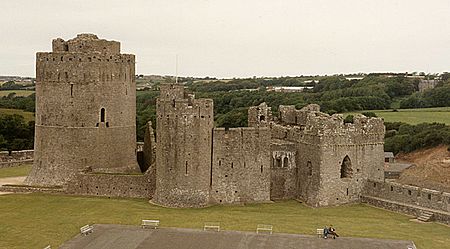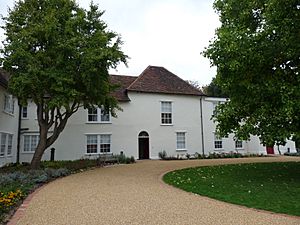Aymer de Valence, 2nd Earl of Pembroke facts for kids
Quick facts for kids
Aymer de Valence
|
|
|---|---|
| Earl of Pembroke | |

19th-century depiction of Pembroke
|
|
| Born | c. 1270 |
| Died | 23 June 1324 (aged 48–49) Ponthieu |
| Buried | Westminster Abbey |
| Wars and battles | |
| Spouse(s) |
|
| Father | William de Valence, 1st Earl of Pembroke |
| Mother | Joan de Valence, countess of Pembroke |
Aymer de Valence, 2nd Earl of Pembroke (born around 1270 – died 23 June 1324) was a very important nobleman in England and France. He was one of the richest and most powerful men of his time.
Aymer played a big part in the arguments between King Edward II and his nobles, especially Thomas, Earl of Lancaster. Aymer was one of the "Lords Ordainers." These lords were chosen to limit the king's power.
However, Aymer's feelings changed when Piers Gaveston, a prisoner he was guarding, was taken and killed. This made Aymer very angry and insulted. After this, he became a strong supporter of the king.
Aymer de Valence was married twice but had no official children. Today, he is mostly remembered because his second wife, Marie de St Pol, started Pembroke College, Cambridge. His beautiful tomb can still be seen in Westminster Abbey. He was also important in the wars where England tried to take over Scotland.
Contents
Aymer's Family and Early Life
Aymer was the son of William de Valence. William was the half-brother of King Henry III. This meant William had a very important position in England. William became the Earl of Pembroke by marrying Joan de Munchensi.
Aymer was the third son in his family. We don't know much about his birth, but it was likely between 1270 and 1275. His older brothers died young. So, Aymer became the heir to the Earldom of Pembroke. He married Béatrice de Clermont before October 1295.
When his father, William de Valence, died in 1296, Aymer inherited his lands in France. But he had to wait until his mother died in 1307 to become the Earl of Pembroke. His first wife, Béatrice, died in 1320. In 1321, Aymer married his second wife, Marie de St Pol.
Aymer owned land all over England, in Ireland, and in France. In 1297, he joined King Edward I in a war in Flanders. He was probably made a knight around this time. Because of his French connections, he was a useful diplomat for the English King in France. He also fought as a military leader in Scotland against Robert the Bruce. In 1306, he won a battle against Bruce at Methven. But the next year, Bruce defeated him at Loudoun Hill.
Challenges with King Edward II
King Edward I died in 1307. His son, Edward II, became king. At first, the new king got along well with his nobles, including Aymer. But soon, problems started. The king's favorite friend, Piers Gaveston, was very unpopular. Gaveston was rude to the nobles and had too much control over King Edward.
In 1311, the nobles created new rules called the Ordinances. These rules greatly limited the king's power over money and choosing officials. Gaveston was also forced to leave the country. Aymer, who was not one of the most extreme nobles, agreed that Gaveston had to go.
Gaveston returned from exile later that year without permission. A group of nobles asked Aymer and the Earl of Surrey to arrest him. They did so on May 19, 1312. But soon after, Thomas of Lancaster and other earls took Gaveston from Aymer's care. They executed Gaveston on June 19.
This act made many people support the king and turned them against the rebellious earls. For Aymer, taking and executing a prisoner who was in his care was a huge insult. It broke the most basic rules of chivalry and honor. This event was a turning point for Aymer. It made him switch his support from the rebels to the king.
Later Years and Legacy
After Gaveston's death, Aymer worked closely with King Edward II. In 1314, he was made the king's leader in Scotland. He was at the terrible English defeat at the Battle of Bannockburn. There, he helped King Edward escape the battlefield.
In 1317, while returning from a trip to France, Aymer was captured by a man named Jean de Lamouilly. He was held for ransom in Germany. The ransom was a huge amount of money, £10,400. This caused Aymer serious money problems for the rest of his life.
Thomas of Lancaster, though disliked for Gaveston's murder, had gained control of the government after England's defeat at Bannockburn. But he was not a good ruler and soon became unpopular. Aymer was one of the important nobles who tried to stop a civil war between the king's supporters and Lancaster's. He helped make the Treaty of Leake in 1318, which gave King Edward back his power.
But peace did not last long. The king had found another favorite, Hugh Despenser the Younger. Despenser became as powerful as Gaveston had been. Aymer's attempts to make peace failed, and civil war began in 1321. In 1322, Lancaster was defeated and executed. Aymer was among the earls who supported this decision. Also in 1322, Aymer started a hospital for people with leprosy in Gravesend.
After the battle of Boroughbridge, Aymer faced problems. Those who opposed Hugh Despenser no longer trusted Aymer. At the same time, the Despensers became more and more powerful at court, pushing Aymer aside. On top of this, he had his financial troubles. On June 23, 1324, while on a trip to France, he suddenly died in Picardy.
Historians have studied Aymer de Valence. Some earlier historians thought he led a "middle party" that tried to find a balance between the king and the rebellious nobles. However, most modern historians now believe that Aymer was mostly loyal to King Edward throughout his life.
Aymer and his sister Agnes once rented an old house in Dagenham, Essex. It has been called Valence House ever since and is now a museum.

Aymer married twice. His first marriage was to Beatrice, daughter of Raoul de Clermont, before 1295. Beatrice died in 1320. In 1321, he married Marie de St Pol. Aymer never had any official children. However, he did have an unofficial son named Henry de Valence.
Aymer's most lasting impact is probably through his second wife, Marie. In 1347, she founded Pembroke College, Cambridge. The family's coat of arms is still on the college's shield. Aymer de Valence was buried in Westminster Abbey. His tomb is a wonderful example of late Gothic art.
Media
Aymer was played by Sam Spruell in the 2018 movie Outlaw King, which is about Robert the Bruce.
Sources
- Phillips, J. R. S. Valence, Aymer de, eleventh earl of Pembroke (d. 1324), Oxford Dictionary of National Biography (Oxford, 2004).
| Legal offices | ||
|---|---|---|
| Preceded by The Lord Monthermer |
Justice in Eyre south of the Trent 1320–1324 |
Succeeded by The Earl of Winchester |
| Peerage of England | ||
| Preceded by William de Valence |
Earl of Pembroke Third creation 1307–1324 |
Extinct |
| New creation | Baron Valence 1299–1324 |
|




